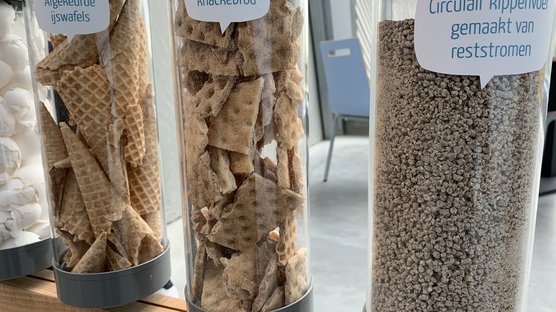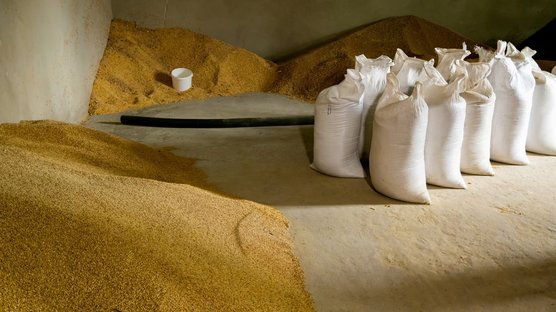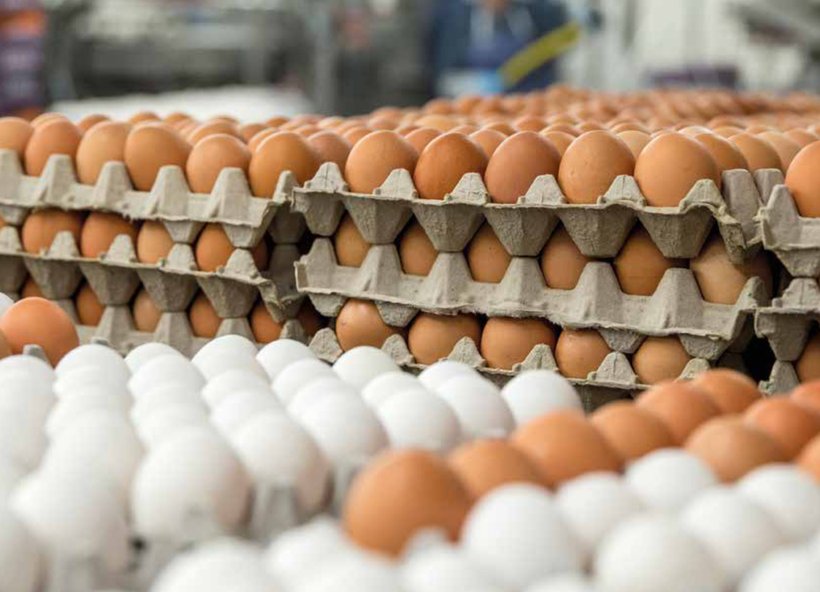
Published on Oct. 1, 2019
The environmental impact of the production of white and brown eggs
According to a recent report from Wageningen University and Research, animal production is responsible for 14.5% of total greenhouse gas (GHG) emissions. Half of these emissions originate directly from animal production, whilst the other half is related to the production of animal feed. The global emission of GHG related to poultry production is lower compared to the GHG emissions of the supply chains of dairy, beef or pork production. Within poultry production we distinguish between egg and meat production. The emission intensity of egg production, defined as the kg CO₂-eq/kg product, is lower compared to broiler meat production (Table 1.). in Figure 1. The global emissions from the egg supply chain are shown by category of the different emissions.
Table 1. Global production, emissions and emission intensity for chickens
| System | Production (Million Tones) | Production (Million Tones) | Emissions (Million tonnes CO₂-eq) | Emissions (Million tonnes CO₂-eq) | Emission intensity (kg CO₂-eq/kg product) | Emission intensity (kg CO₂-eq/kg product) |
| Eggs | Meat | Eggs | Meat | Eggs | Meat | |
| Backyard | 8,3 | 2,7 | 35,0 | 17,5 | 4,2 | 6,6 |
| Laying hens | 49,7 | 4,1 | 182,1 | 28,2 | 3,7 | 6,9 |
| Broilers | 64,8 | 343,3 | 5,3 | |||
| Totals | 58,0 | 71,6 | 217,0 | 389,0 | 3,7 | 5,4 |
As a breeding company we have the aim to further improve our hen’s productivity whilst optimizing their efficient use of resources. This directly results in a reduction of the environmental impact of egg production. As a result of our balanced breeding program, our hens are able to produce more eggs within the same production cycle. But they can also be kept for longer production cycles as they are able to produce more 1st quality eggs as the result of selecting for improved livability and egg quality up to 100 weeks of age.
The results of the Wageningen study showed that breeding reduces environmental impacts of animal products by about 1% per year (for this study, data of Hendrix Genetics and the other partners in the Breed4Food consortium has been used). This is achieved as an indirect response through selection on increased (feed) efficiency. Specific selection on environmental traits is not done within our current breeding program for laying hens. The current results are achieved by improving the hens feed efficiency, e.g. more eggs produced with the same amount of feed consumed, improved persistency (keeping the hens productive for longer periods), and selecting for better health and livability (improving robustness of the birds). The authors stated that if it is desired to select directly on environmental traits, the recording of new traits is required, e.g., nitrogen and phosphorus contents of eggs and spent hens.
Figure 1. Global emissions from egg supply chains by category of emissions.
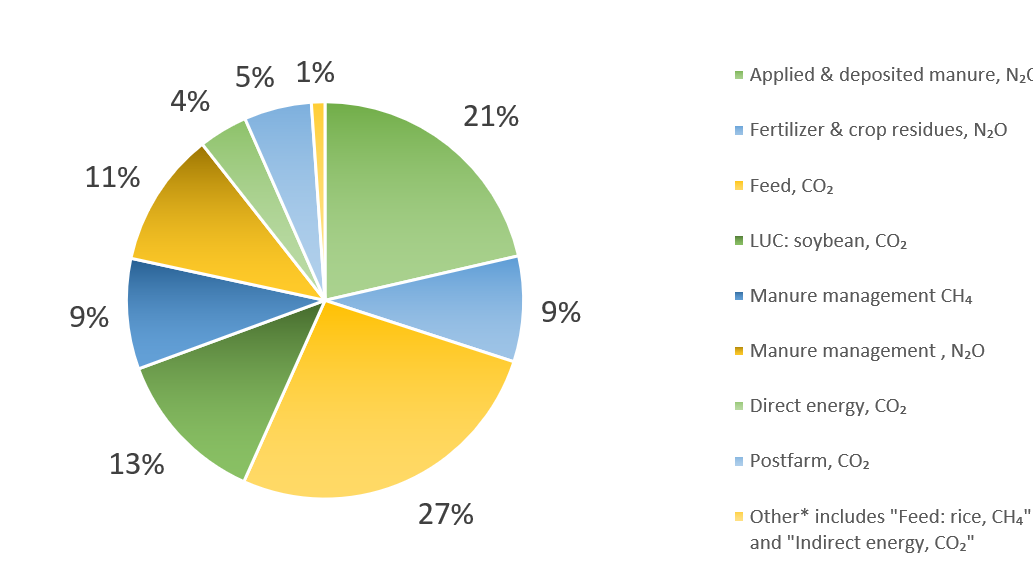
Source: Gerber et al, FAO (2013)
In their study, a quantitative assessment was made on the current environmental impact of chicken eggs. The focus was on GHG emissions and nitrogen and phosphorus efficiency. Using this method, the authors performed the GHG emission calculations based on the whole chain, e.g. including the impact of the parent stock and of the rearing phase. From their study they concluded that white hens have a lower GHG impact and better N and P efficiency than brown hens. Besides this, improvements over the past decade were faster in white laying hens compared to brown. Linear extrapolation of genetic progress was applied to predict the 2030 performance for both brown and white laying hens, from which they predict that the future improvements in the white egg layers will be bigger compared to the brown. This is likely to result in an even bigger gap between white and brown egg layers in the years to come!
Figure 2. GHG-emissions (g CO₂ -eq / kg eggs)
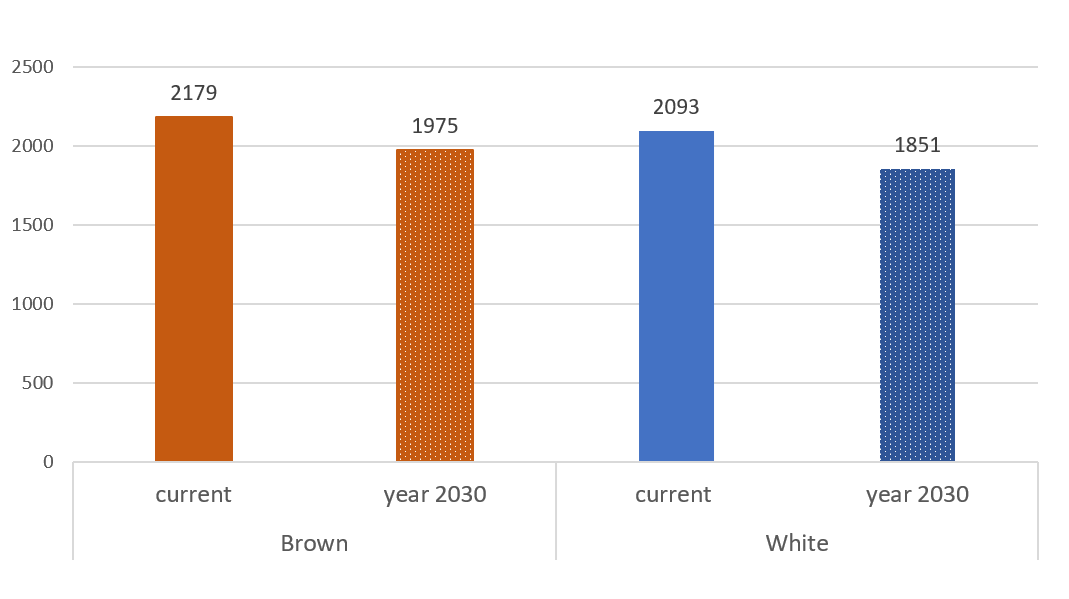
Source: Mollenhorst & de Haas (2019)
Results from different independent Random Sample Tests also clearly shows the advantage of white laying hens compared to brown hens (Tables 2, 3 & 4). Better persistency and better livability result directly in more eggs per hen housed, together with lower feed intake as a result of lower energy requirements for the bird’s maintenance (due to lower bodyweights). This results directly in better efficiency in white laying hens compared to brown laying hens. Average egg size is in general lower for birds producing white eggs compared to birds producing brown eggs, but when you look at the total egg mass produced per hen housed, the advantage of white laying hens becomes clearly visible.
Table 2. results from the 14th Bayern Random Sample Test for Laying hens in Floor Systems
| Eggs HH | % Lay | Ø Egg weight grams | Ø Egg mass HH kg | Ø Feed intake g/day | Ø Feed Conversion kg feed/kg eggs | Bodyweight 72 weeks kg | % mortality | |
| Ø Brown | 300,2a | 82,5a | 63,6a | 19,1a | 122,2a | 2,253a | 1,949a | 9,23a |
| Ø White | 325,3b | 89,4b | 62,5b | 20,3b | 118,9b | 2,105b | 1,742b | 3,07b |
| difference | +25,1 | +6,9 | -1,1 | +1,2 | -3,3 | -0.148 | -0.207 | -6,16 |
a,b, Different letters within the same column denote significant differences (P <0.05) between Brown and White laying hens
Source: Damme et al. (2019)
Table 3. results from the 40th North Carolina Random Sample Test for Laying hens in Conventional Cage Systems
| Eggs HH | % Lay | Ø Egg weight grams | Ø Egg mass gram / day | Ø Feed intake g/day | Ø Feed Conversion kg feed/kg eggs | Bodyweight 89 weeks kg | % mortality | |
| Ø Brown | 397,88a | 82,88a | 60,66 | 50,71a | 105,6a | 2,083a | 2,07a | 15,03a |
| Ø White | 412,24b | 86,89b | 60,36 | 53,21b | 102,2b | 1,923b | 1,76b | 12,31b |
| difference | +14,36 | +4,01 | -0,3 | +2,5 | -3,4 | -0,160 | -0,31 | -2,72 |
a,b, Different letters within the same column denote significant differences (P <0.05) between Brown and White laying hens
Source: Anderson (2018)
Table 4. results from the 40th North Carolina Random Sample Test for Laying hens in Cage Free Systems
| Eggs HH | % Lay | Ø Egg weight grams | Ø Egg mass gram / day | Ø Feed intake g/day | Ø Feed Conversion kg feed/kg eggs | Bodyweight 89 weeks kg | % mortality | |
| 351,67a | 79,62a | 61,07a | 49,00a | 106,6a | 2,17a | 2,07a | 19,28a | |
| Ø White | 417,54b | 84,02b | 60,34b | 51,04b | 103,7b | 2,00b | 1,82b | 2,92b |
| difference | +65,87 | +4,4 | -0,73 | +2,04 | -2,9 | -0,17 | -0,25 | -16,36 |
a,b, Different letters within the same column denote significant differences (P <0.05) between Brown and White laying hens
Source: Anderson (2018)
Although in certain markets white eggs have often been associated with cage production systems, we see that several European markets that have made the move to cage-free housing systems in combination with keeping birds with intact beaks have also made the switch to white hens. The Netherlands and Germany are clear examples of countries where this trend is happening. Retailers, like Lidl in the Netherlands, have completely made the change to offer only white eggs to their customers as part of their sustainability commitments and goals. We also hear and see from egg producers all over the world that the hens that are producing white eggs can be kept for longer production cycles, are easier to manage in alternative systems and produce less floor eggs. A clear example is the Lux family farm, who have been able to keep their flock of Dekalb White birds until 100 weeks of age and have produced more than 500 eggs per hen housed!
References:
Anderson, K.E., 2018. Single cycle report of the fortieth North Carolina Layer Performance and Management Test Vol. 40, No. 4 September 2018
Damme, K., R. Schreiter, M. Schneider, T. Kneuder, R.A., Hildebrand, 2019. 14. Bayerischer Herkunfstvergeleich von Legehybriden in Bodenhaltung, März 2019
Gerber, P.J., Steinfeld, H., Henderson, B., Mottet, A., Opio, C., Dijkman, J., Falcucci, A. & Tempio, G. 2013. Tackling climate change through livestock – A global assessment of emissions and mitigation opportunities. Food and Agriculture Organization of the United Nations (FAO), Rome.
Mollenhorst, H., Y. de Haas, 2019. The contribution of breeding to reducing environmental impact of animal production. Wageningen Livestock Research, Report 1156.


